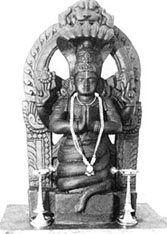What is Yoga
योगश्चित्तवृत्तिनिरोधः (yogaś citta-vṛtti-nirodhaḥ) – Yoga Sutra 1.2 of Patanjali Yoga Sutras
According to Baba Hari Dass, “Yoga (union) implies duality (as in joining of two things); the result of yoga is the non-dual state”, and “as the union of the lower self and higher Self. The non-dual state is characterized by the absence of individuality; it can be described as eternal peace, pure love, Self-realization, or liberation.”
The word “YOGA” literally, it means “union.” Union means it brings you to the ultimate reality.
Yoga is a group of physical, mental and spiritual practices. Yoga in Indian traditions, however, is more than physical exercise; it has a meditative and spiritual core. The origins of yoga have been speculated to date back to pre- Vedic times most likely developed around the sixth and fifth centuries BC.
The ultimate goal of Yoga is MOKSHA (liberation) by controlling the body and the mind.
Classical Yoga
 Yoga is considered as a philosophical school in Hinduism. The Yoga Sutras of Patanjali is considered as the foundational scripture of classical yoga. Patanjali was an avatar of the divine serpent Shesha.
Yoga is considered as a philosophical school in Hinduism. The Yoga Sutras of Patanjali is considered as the foundational scripture of classical yoga. Patanjali was an avatar of the divine serpent Shesha.
The book Yoga Sutras of Patanjali has 196 verse’ and is divided into four Chapters or Pada:
- Samadhi Pada
- Sadhana Pada
- Vibhuti Pada
- Kaivalya Pada
Patanjali Yoga
Patanjali’s Yoga Sutras are regarded as the first compilation of the formal yoga philosophy. The verses of Yoga Sutras are short and brief. Many Indian scholars studied them and published their commentaries, such as the Vyasa Bhashya.
Ashtanga Yoga
The Ashtanga Yoga, the eight limbs are being practiced to attain samadhi, as described in the Yoga Sutras of Patanjali.
Ashtanga yoga incorporates epistemology, metaphysics, ethical practices, systematic exercises and self-development techniques for body, mind and spirit. “Ashtanga Yoga” (“Eight-Limbed Yoga”) includes :
- YAMA (The five “abstentions”):
- Ahimsa(Non-violence, non-harming other living beings),
- Satya(truthfulness, non-falsehood),
- Asteya (non-stealing),
- Brahmacharya(celibacy) and
- Aparigraha(non-avarice, non-possessiveness).
- NIYAMA (The five “observances”):
- Śauca(purity, clearness of mind, speech and body),
- Santosha(contentment, acceptance of others and of one’s circumstances),
- Tapas(persistent meditation, perseverance, austerity),
- Svādhyāya(study of self, self-reflection, study of Vedas) and
- Ishvara-Pranidhana(contemplation of God/ Supreme Being/ True Self).
- ASANA:
Literally means “seat”, and in Patanjali’s Sutras refers to the seated position used for meditation.
- PRANAYAMA(“Breath exercises”):
Prāna, breath, “āyāma”, to “stretch, extend, restrain, stop”.
- PRATYAHARA(“Abstraction”):
Withdrawal of the sense organs from external objects.
- DHARANA(“Concentration”):
Fixing the attention on a single object.
- DHYANA(“Meditation”):
Intense contemplation of the nature of the object of meditation.
- SAMADHI(“Liberation”):
Merging consciousness with the object of meditation.

